Exploring Sheer Satin Fabric in Modern Fashion Trends
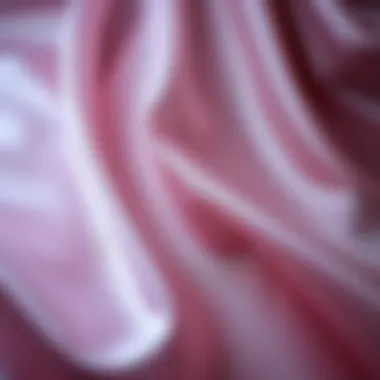
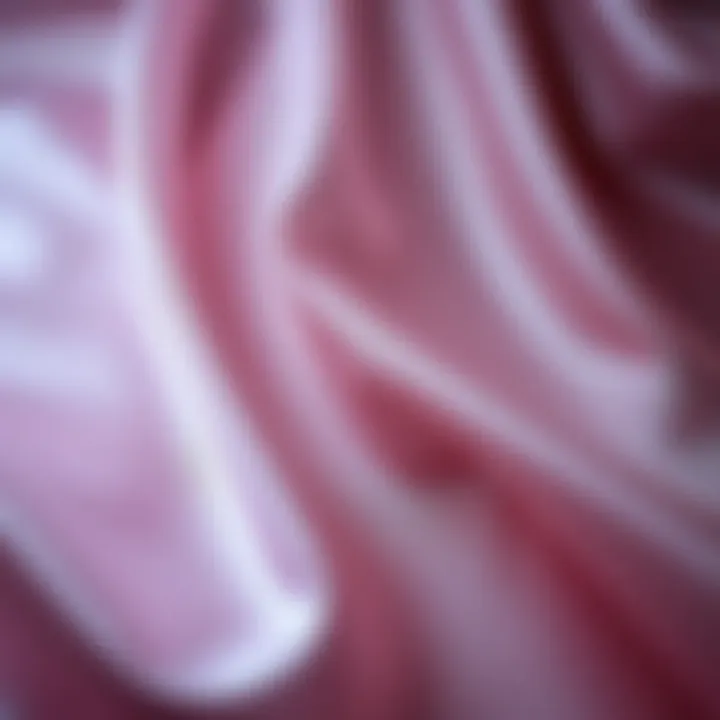
Intro
In the ever-evolving tapestry of modern fashion, sheer satin fabric has carved out a niche that speaks to both elegance and contemporary flair. Known for its delicate sheen and soft drape, sheer satin presents a fascinating interplay between transparency and style, making it a favored choice among designers and fashion enthusiasts alike. As we delve deeper into the multifaceted nature of this fabric, we uncover its historical roots, unique characteristics, and role in current fashion trends. This exploration not only sheds light on its aesthetic appeal but also examines sustainability practices that are increasingly influencing its production and use.
Latest Fashion Trends
Seasonal Style Highlights
The appearance of sheer satin in seasonal collections often marks a shift towards more fluid lines and luxurious finishes. In recent seasons, designers have turned their attention to incorporating this versatile fabric into various garment types, from flowing dresses to structured tops. For instance, in the spring collections, sheer satin blouses often featured billowy sleeves and cinched waists, creating a juxtaposition of softness and form.
Moreover, during fall runway shows, we’ve seen a surge in sheer satin skirts layered over solid slips, emphasizing both texture and dimension. This trend caters to the growing appetite for layering as a means of personal expression, allowing wearers to mix and match various styles and patterns. Overall, the seasonal highlights showcase sheer satin's adaptability, confirming its importance in any fashion-forward wardrobe.
Influential Runway Looks
Some notable designers have showcased sheer satin in groundbreaking ways during their runway presentations. For example, Alexander McQueen’s recent collection featured an avant-garde approach, offsetting sheer satin dresses with bold accessories that hybridized different materials. This kind of juxtaposition not only enhances the fabric's opulence but also responds to the current penchant for statement pieces.
In contrast, Chanel presented sheer satin in a more understated manner, such as using it for elegant overlay coats that lent a hint of glamour to everyday outfits. The versatility of sheer satin, as demonstrated on these runways, reveals how designers are pushing boundaries while staying rooted in the fabric's intrinsic qualities.
"Sheer satin is not just a fabric; it’s an experience that embodies both tradition and modernity in fashion."
Sustainable Fashion Practices
Ethical Sourcing of Materials
As the fashion industry grapples with its environmental impact, the conversation surrounding the sustainability of materials has heightened. Sheer satin, predominantly made from silk, poses unique challenges but also significant opportunities. Ethical sourcing is becoming vital as consumers demand transparency in fashion. Designers are now partnering with suppliers that follow fair trade principles, ensuring that the silk is harvested in ways that don’t exploit workers or harm the ecosystem.
Some brands have also begun experimenting with recycled polyester satin, which maintains the luxurious feel of sheer satin while reducing the environmental footprint. This shift not only addresses sustainability concerns but also invites innovative design possibilities.
Eco-Friendly Clothing Care
Caring for sheer satin clothing also plays a role in its sustainability journey. Gentle washing methods, such as hand washing with mild detergents or using delicate cycles, are recommended to prolong the life of these garments. Moreover, air drying rather than tumble drying is advised to avoid wear and tear.
To further maintain the integrity of sheer satin, it's crucial to store items away from direct sunlight, as exposure can lead to fading. Employing protective garment bags or cotton coverings can ensure that these pieces remain in pristine condition for years to come.
Prelims to Sheer Satin Fabric
Sheer satin fabric occupies a unique position in the realm of modern fashion, embodying both elegance and versatility. This type of fabric can be light as a feather yet carries an aura of luxury that’s often sought after by designers and consumers alike. Endlessly adaptable, it serves multiple purposes: from alluring evening gowns to breathy blouses. The increasing demand for such fabrics points to their significance not only in aesthetics but in providing a sense of fluidity and freedom in attire.
Definition and Characteristics
Sheer satin is known for its delicate and lustrous appearance. Defined primarily by its high glossy surface paired with a transparent quality, this fabric is typically composed of lightweight fibers such as silk, polyester, or a blend. The beauty of this fabric lies in its soft hand-feel, which makes draping effortless and creates alluring silhouettes.
One distinctive feature of sheer satin is its ability to reflect light, giving it a luxurious sheen that enhances visual appeal. This quality has made it a favored choice for many fashion designers, as it allows for striking visual effects, especially in evening wear where glamour is the order of the day.
Beyond aesthetics, sheer satin’s lightweight and breathable nature makes it suitable for warmer climates and events. It flows beautifully when worn, accentuating the movements of the body without constricting it. For instance, a sheer satin dress can flutter with a gentle breeze, creating an enchanting visual narrative.
Historical Context
Tracing the roots of sheer satin leads us back to ancient times when silk was first discovered in China. The luxurious nature of silk fabric quickly captured the attention of major empires, setting the stage for the evolution of various satin weaves throughout history. The term "satin" itself hails from the Arabic word "zaitun," referring to a location in ancient Persia where the fabric was first developed.
With time, satin made its way to Europe, particularly during the Middle Ages and the Renaissance, where it was reserved for the elite classes. The fabric was often utilized in royal garments, highlighting its status as a symbol of wealth and prestige. Over the centuries, sheer satin has transformed from a fabric primarily reserved for the upper crust to an accessible choice in contemporary shops.
In the modern fashion landscape, sheer satin has emerged as a canvas for both traditional craftsmanship and innovative design. Renowned designers often blend historical elements with current trends, striking a delicate balance between their heritage and the modern aesthetic.
Ultimately, understanding sheer satin's historical context enhances appreciation for its evolving nature, spotlighting its role in contemporary fashion. As a fabric that bridges the ancient past with today’s creative expressions, sheer satin continues to inspire and captivate fashion enthusiasts and professionals alike.
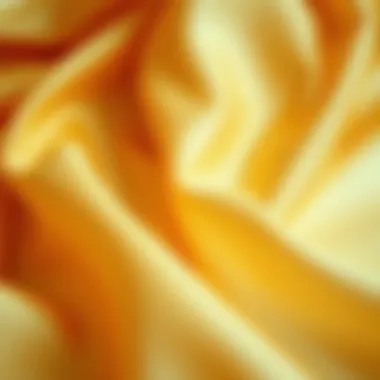

Understanding Fabric Composition
When diving into the world of sheer satin fabric, understanding its composition becomes essential for grasping its role in modern fashion. The interplay of various materials and techniques crafts the fabric’s signature feel, appearance, and performance. In this section, we will unfold the nuances of what goes into making sheer satin and how these elements influence its appeal in contemporary apparel.
Materials Used in Sheer Satin
Sheer satin boasts unique qualities, largely due to the materials involved in its creation. The primary component is silk, known for its glossy finish and soft texture. However, with a shift towards sustainability and affordability, synthetic fibers like polyester and acetate are frequently utilized as alternatives. These synthetic variants often come at a lower price but can still offer that coveted sheen.
Key Materials in Sheer Satin:
- Silk: Offers unmatched luxury and breathability.
- Polyester: Durable and stain-resistant, making it practical for everyday wear.
- Acetate: Mimics silk's glossy finish; often used in evening wear.
The choice between natural and synthetic influences not just the look, but also the feel and care required for the fabric. Silk satin, while luxurious, demands more meticulous handling compared to its synthetic counterparts which are generally easier to maintain. This can play a significant role in designers' choices, particularly in markets where cost and maintenance are top priorities.
Weaving Techniques
Weaving techniques play a pivotal role in determining the character of sheer satin fabric. The most common methods are satin weave and twill weave, each contributing differently to the texture and opacity of the fabric.
- Satin Weave: Involves floating yarns which create a smooth surface, resulting in the characteristic shine. This technique allows for light to reflect beautifully, enhancing the visual depth of colors.
- Twill Weave: By creating diagonal lines on the fabric's surface, twill can soften the sheen effect and add structure. While less common in sheer satin, some designers experiment by combining these methods to achieve a unique aesthetic.
"The art of weaving satin not only defines quality but also the spirit of the garment created from it."
Understanding these techniques is crucial for designers who wish to manipulate the fabric's characteristics for desired silhouettes. The choice between these weaves can significantly affect draping, which is vital for achieving the fluid lines that are a hallmark of garments made with sheer satin. The right technique can elevate a design from ordinary to extraordinary, making it essential to explore these weaving methods in depth.
By examining the materials and weaving techniques that compose sheer satin, we gain insights into not just its characteristics but also its boundless applications in fashion design. The intricate nature of its composition lays the groundwork for understanding how this fabric continues to influence trends and styles.
The Unique Qualities of Sheer Satin
Sheer satin fabric stands out in the fashion world not just for its stunning appearance but also for its unique qualities that lend themselves beautifully to a myriad of design applications. Understanding these characteristics can elevate one's fashion collection or wardrobe, making sheer satin a perennial favorite among fashion enthusiasts and professionals alike.
Texture and Sheen
One of the first elements that catches the eye with sheer satin is its luxurious texture. This fabric has a smooth, lustrous finish that reflects light in a way that can only be described as mesmerizing. This innate sheen is not merely aesthetic; it plays a significant role in how garments drape and flow on the body. The soft texture allows for graceful movement, enhancing the overall elegance of the wearer. Many designers appreciate how sheer satin can elevate a simple design with its opulent look, transforming a basic silhouette into something spectacular.
Additionally, sheer satin often boasts a soft handfeel which makes it comfortable against the skin. This inviting quality makes it a prime choice for garments meant to be worn on special occasions. When one runs a hand over a piece made from sheer satin, it’s hard not to be captivated by that sensuous touch—something many consumers actively seek in fabric choices for evening wear or bridal attire.
Moreover, the texture can be manipulated in various ways. Designers can use pleating, ruching, or draping techniques to create shapes that enhance a garment's visual appeal. In this sense, sheer satin is both a canvas and a tool, giving designers the latitude to explore their creative visions.
"The sheer satin's ability to transform low-key patterns or simple cuts into something exceptional lies in its unique interplay with light and touch. Its texture invites exploration and innovation in wardrobe choices."
Lightweight Nature
Another hallmark of sheer satin is its lightweight nature. This attribute offers significant advantages when it comes to layering or creating flowing silhouettes. Unlike heavier fabrics that can weight down a design, sheer satin allows for intricate layering effects, giving garments an ethereal quality. In modern fashion, where the art of layering can make or break an outfit, sheer satin emerges as the fabric of choice for savvy designers.
The lightweight aspect also plays into comfort and practicality. Clothes made from this fabric are less restrictive, allowing free movement. This is especially vital in contemporary designs that merge comfort with style, as consumers increasingly prioritize wearability alongside aesthetics. For instance, a sheer satin blouse paired with tailored pants creates a balanced look that is both refined and effortless.
In addition, sheer satin’s lightness aids in achieving that elusive floaty look many aim for in evening dresses or summer wear. It can easily be transformed for both daytime outfits or more opulent evening wear, thus providing versatility that resonates with various customer needs, from casual to formal engagements.
In sum, sheer satin's charm and functionality lie in its unique properties of texture and weight. It can enrich a fashion assortment significantly, proving to be a worthwhile fabric in anyone's collection.
Applications in Fashion Design
Sheer satin fabric has carved out a notable niche in modern fashion, playing a pivotal role in both high-end couture and everyday styles. This fabric elegantly blends aesthetics with functionality, appealing to designers and consumers alike. One of the most significant benefits of using sheer satin is its ability to elevate the sophistication of a garment while providing breathability and comfort. Its smooth texture and stunning lustre make it a favorite choice for various applications, from red carpet events to casual outings.
Evening Wear and Haute Couture
When it comes to evening wear, sheer satin stands out as a material that transforms basic designs into breathtaking pieces. Its lustrous finish catches the light beautifully, making it ideal for gowns and formal attire. Designers like Elie Saab and Valentino have utilized this fabric in their collections, creating flowing skirts that dance with movement. The lightweight nature of sheer satin allows for layers, which enhances the fluidity of draped silhouettes.


- Key Features of Sheer Satin in Evening Wear:
- Adds a dreamy quality to looks
- Perfect for layering, creating ethereal gowns
- Enhances design details such as ruching and ruffles
For instance, a sheer satin evening gown can offer an elegant cascade of fabric that can make a statement on any occasion. The fabric's soft drape allows designers to create striking color combinations, accentuating curves or flowing straight for a more classic look. Moreover, the transparency can be subtly employed, allowing glimpses of skin without compromising modesty, appealing to a diverse audience.
Casual and Everyday Wear
Moving from the runway to the streets, sheer satin has found its way into casual and everyday wear. While it may seem more luxurious, the versatility of sheer satin means it can be adapted for day-to-day use.
- Examples of Casual Applications:
- Blouses that pair perfectly with jeans or trousers
- Dresses suitable for brunch or a day out
- Skirts that add style without sacrificing comfort
Brands like Zara and H&M have embraced sheer satin in their casual collections, resulting in pieces that feel modern yet comfortable. A basic sheer satin top can effortlessly dress up a pair of jeans, taking a simple ensemble from boring to chic with ease. This adaptability is vital in contemporary fashion, where consumers seek to balance style with everyday practicality.
"Sheer satin bridges the gap between luxury and function, making it an essential in modern wardrobe staples."
Styling with Sheer Satin
In today’s fast-evolving fashion arena, sheer satin fabric stands as a beacon of elegance and versatility. Understanding how to style this fabric isn’t just about the aesthetic; it embodies a blend of creativity, functionality, and trend awareness. Sheer satin can elevate even the simplest outfit, transitioning it from mundane to remarkably exquisite. Its unique characteristics mean that styling requires careful thought regarding layering and color choices.
Layering Techniques
Layering sheer satin proves to be an art that when done well, transforms an outfit into a multidimensional masterpiece. One effective approach is to start with a staple piece — a fitted top or a midi skirt. That base provides structure while the sheer satin layer adds an ethereal touch. Consider a sheer satin overlay over a fitted lace top, allowing the textures to play off each other. This technique works well for evening events, giving depth and visual intrigue.
- Play with Lengths: When layering, varying the lengths can create a visually interesting silhouette. A longer satin duster can pair beautifully over a shorter dress.
- Textural Contrast: Mix sheer satin with other fabrics to break monotony. Pairing it with more substantial materials like denim or wool can create an ensemble that feels both modern and sophisticated.
- Belted Layers: Adding a belt over a layered outfit made from sheer satin can help define the waist and add shape, ensuring you don’t lose your silhouette among the floating layers.
Color Coordination
The color coordination of sheer satin is paramount in achieving a harmonious outfit. Soft pastels tend to reflect light beautifully and can create a dreamy vibe, ideal for a relaxed daytime look. In contrast, vibrant hues can make a bold statement, commanding attention.
- Monochrome Looks: Sticking to shades of the same color can present a sleek appearance, especially with sheer satin, which can easily shift from one hue to another depending on the layer beneath it.
- Opposite Colors: For those feeling adventurous, using complementary colors on the color wheel can pack a punch. For example, a rich emerald green satin over a royal blue foundation showcases a striking contrast.
- Accents Matter: Don’t forget about the accessories. Metallics or nude tones can elevate a satin piece without overwhelming it. A pair of sleek heels or a clutch in a complementary shade will tie the whole look together beautifully.
As you delve into the world of sheer satin, remember that the fabric’s inherent delicacy and shine offers a canvas for creativity. Whether you choose to layer or focus on color coordination, the key is to play around until you find combinations that feel uniquely yours. Fashion is about personal expression, so let sheer satin serve as an extension of your creative vision.
Maintenance and Care
Caring for sheer satin fabric requires special attention due to its delicate structure. While the beauty of this material amplifies the allure of any garment, improper handling can lead so to unexpected wear and tear. Proper maintenance ensures that sheer satin retains its characteristics, including its lustrous sheen and lightweight feel, offering longevity in your wardrobe.
In the world of fashion, sheer satin can be a significant investment, often featured in high-end collections and meticulously designed pieces. Thus, understanding how to maintain and care for these fabrics can prevent the frustrations associated with damage or premature aging.
Washing and Cleaning Instructions
When it comes to cleaning sheer satin, gentleness is your best friend. The common mantra of "less is more" rings especially true here. Here are some insights on how to approach the washing and cleaning of sheer satin:
- Hand Wash Recommended: For best results, opt to hand wash your sheer satin garments. Fill a basin with cool, mild soapy water, and gently agitate the fabric. Avoid any excessive rubbing or twisting.
- Use Mild Detergent: Stick with a gentle, pH-balanced detergent designed for delicates. Avoid bleach or harsh chemicals that can tarnish the fabric’s delicate nature.
- Cold Water Rinse: After washing, rinse thoroughly with cold water until no soap residue remains. Hot water can negatively affect the sheen and elasticity of satin.
- Air Dry: Instead of throwing your sheer satin into the dryer—or even wringing it out—gently squeeze out excess water and lay it flat on a towel to dry. Avoid direct sunlight to prevent fading.
Tip: For stubborn stains, it’s best to consult a professional cleaner who specializes in delicate fabrics. They have the right tools to handle such inquiries without risking damage.
Storage Solutions
Proper storage is as crucial as cleaning when it comes to maintain sheer satin. By following a few simple guidelines, you can extend the life of your satin pieces:
- Use Breathable Garment Bags: Keeping sheer satin in breathable fabric garment bags can prevent dust accumulation while allowing airflow. This aids in maintaining the fabric’s integrity and avoids trapped moisture.
- Avoid Hangers: Instead of hanging sheer satin garments on traditional hangers, opt for padded or non-slip hangers. This minimizes the risk of creasing or stretching that can happen with standard hangers.
- Keep Away from Direct Light: Store your sheer satin in a cool, dark place away from direct sunlight, as UV rays can lead to discoloration over time.
- Regular Checks: Periodically check stored satin clothes for any signs of mildew or pests. Address issues immediately to prevent further damage.
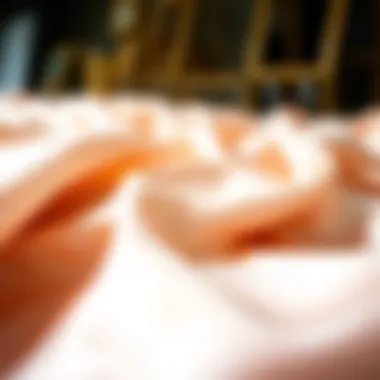
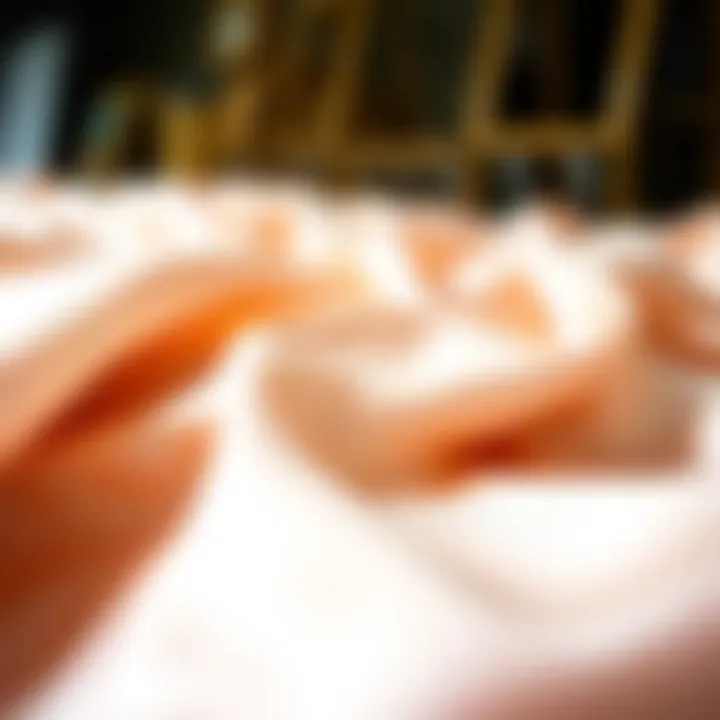
By taking time for both maintenance and care, you not only preserve the fabric's beauty but also ensure that your investment remains a staple in your wardrobe for years to come. Understanding the nuances of sheer satin maintenance reflects an appreciation for the craftsmanship that goes into making these luxurious garments.
For further insights, websites like Wikipedia and resources on Britannica can provide more background on fabric care specifics, enhancing your knowledge in caring for luxurious materials.
Sustainability Considerations
Sustainability within the fabric industry is no longer just a buzzword; it's becoming a core value that shapes consumer choices and influences how brands operate. When we talk about sheer satin, attention to sustainability adds a layer of complexity and responsibility to its allure in fashion.
There's a growing awareness among shoppers today. They often opt for products that not only look great but also don’t harm the planet. The fabric doesn't exist in a vacuum; its production has ripple effects on ecosystems and communities. Emphasizing sustainable practices allows designers to create pieces that resonate with both trend-savvy consumers and conscientious buyers who seek to align their wardrobe with their values.
Environmental Impact of Satin Production
Sheer satin fabric is typically made from synthetic fibers, primarily polyester or nylon. The production of these materials raises several sustainability concerns.
- Resource Intensive: The manufacturing process for synthetic fibers requires significant amounts of water and energy, contributing to environmental degradation.
- Chemical Usage: The dyeing and finishing processes often involve toxic chemicals, which can lead to water pollution if not handled properly.
- Waste Generation: The end-of-life stage of synthetic fabrics can create a considerable waste problem, as they do not decompose easily. This means that many sheer satin garments may end up in landfills, which is not great news for our planet.
Retailers and designers are working towards reducing these impacts by implementing more eco-conscious practices like utilizing recycled materials and improving production methods. The shift toward sustainable sheer satin not only addresses environmental concerns but can also enhance a brand’s image, showcasing a commitment to responsible fashion.
Ethical Sourcing Practices
In addition to environmental concerns, the ethical implications of fabric sourcing cannot be ignored. Transparency is critical in today’s fashion landscape. Consumers want to know where their products come from and what social implications they entail.
- Fair Labor: Ethical sourcing means ensuring that workers involved in the production process are paid fairly and work in safe conditions. Most consumers feel better knowing that their garments are made by teams that are treated with dignity.
- Local Sourcing: More designers are considering local sourcing to reduce the carbon footprint associated with transporting materials across the globe. This approach can also strengthen local economies.
- Traceability: Brands that provide information about their supply chains instill trust in consumers. By tracking where the materials come from, companies can assure buyers that they are not supporting exploitative practices.
In summary, addressing these sustainability considerations in the production of sheer satin fabric — from minimizing environmental damage to ensuring fair labor conditions — becomes vital. It’s about crafting a future where fashion does not come at the expense of the planet or its people. As consumers become more discerning, the importance of sustainability in sheer satin will only continue to rise, shaping the next wave of fashion innovation.
Contemporary Trends in Sheer Satin Fashion
In recent years, sheer satin has carved out a niche for itself in modern fashion, gaining popularity among designers and consumers alike. This resurgence reflects changing tastes and a growing appreciation for innovative textiles that blend comfort with elegance. Understanding contemporary trends in sheer satin helps illuminate its significance in today’s fashion landscape. Various elements, such as social platforms and celebrity endorsements, play crucial roles in shaping consumer decisions and influencing design choices. In this section, we delve into these aspects, revealing how sheer satin's charm continues to captivate fashion enthusiasts across the globe.
Influence of Social Media on Fabric Choices
Social media platforms like Instagram and TikTok have become vital spaces for fashion dialogue, influencing how consumers perceive and choose fabrics. Sheer satin, with its lustrous finish and airy draping capabilities, captures attention instantly on feeds packed with visual content. Influencers often showcase their outfits featuring sheer satin, sharing styling tips and inspiring their followers to experiment with this luxurious fabric.
The immediacy of social media allows trends in sheer satin to spread like wildfire. For example, a stunning sheer satin dress worn by a popular influencer can lead to increased searches for similar items or even DIY tutorials on how to make them. It fosters a culture of accessibility, where what once seemed exclusive is now just a few clicks away. Social media also empowers consumers to engage with brands more directly, sharing personal experiences with sheer satin and fostering community discussions that further boost its appeal.
"The fabric choices showcased on social media are no longer just trends—they are a visual conversation that shapes consumer preferences and expectations.”
Celebrity Endorsements and Their Impact
The role of celebrity endorsements in fashion cannot be overstated. A well-timed appearance of a celebrity in sheer satin can significantly influence consumer behavior and perspective. When A-list stars grace red carpets in flowing satin gowns, the allure of the fabric skyrockets. Take, for instance, Beyoncé’s dazzling sheer satin ensemble at a recent awards show. The image becomes iconic, not just for its beauty but for how it sets a trend, encouraging consumers to seek out similar styles from the same or different designers.
Such endorsements play a pivotal role in reinforcing the idea of sheer satin as a go-to fabric for various occasions, from high-end events to casual outings. Retailers frequently capitalize on this by marketing their sheer satin collections in ways that resonate with consumers, often emphasizing its versatility and glamor. Customers are more inclined to invest in pieces that mirror the styles showcased by their favorite stars, making sheer satin synonymous with modern elegance and sophistication.
Epilogue
The exploration of sheer satin fabric in modern fashion highlights not just its aesthetic appeal but also its nuanced complexities. Sheer satin is more than just a choice fabric; it's a testament to the evolving nature of fashion itself. Its lightweight characteristics, beautiful sheen, and versatile applications make it a staple in evening wear and casual outfits alike. But as we dissect its role further, we find that sheer satin carries implications beyond mere style.
The Future of Sheer Satin in Fashion
Looking ahead, the future of sheer satin is promising yet necessitates a mindful approach. As designers continue to innovate, the demand for this fabric rises, melding tradition with modernity. Sustainability is likely to play a vital role moving forward. The fashion industry, under scrutiny for its environmental footprint, will push for ethical production methods in sheer satin manufacturing. Brands that can integrate eco-friendly practices into their satin lines will likely gain a competitive edge.
Additionally, with the influence of social media and celebrity culture, sheer satin is bound to see varied reinvention. Designers can leverage platforms like Instagram to showcase their creations, turning sheer satin into a buzzworthy trend almost overnight. Whether it’s through influencer partnerships or viral fashion challenges, its adaptability for different demographics ensures its place in high fashion and everyday styles.
"Fashion is about going up the ladder, what’s in today might be out tomorrow. Yet sheer satin, with its flexible appeal, simply won’t fade away."
As trends shift and consumer awareness grows, sheer satin offers a rich avenue for both exploration and expression in the ever-changing fashion landscape.
Relevant Resources
- Wikipedia on Satin
- Britannica's Fabric History
- Sustainable Fashion Discussion on Reddit
- Fashion Retail Guidelines
- Ethical Sourcing Practices in Fashion
Through a careful understanding of sheer satin, both fashion enthusiasts and retail professionals can embrace its future potential while navigating the complexities that come with it.







